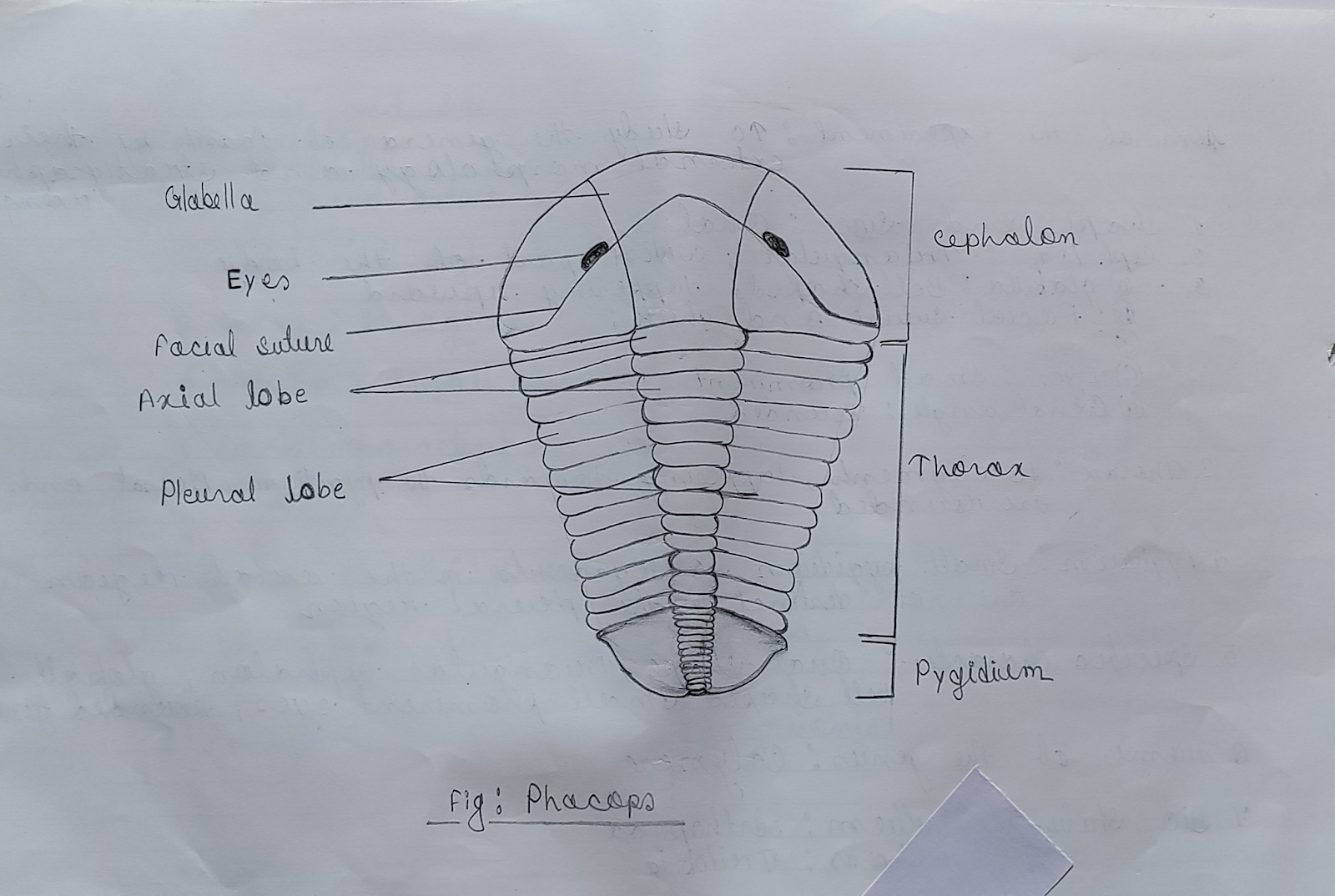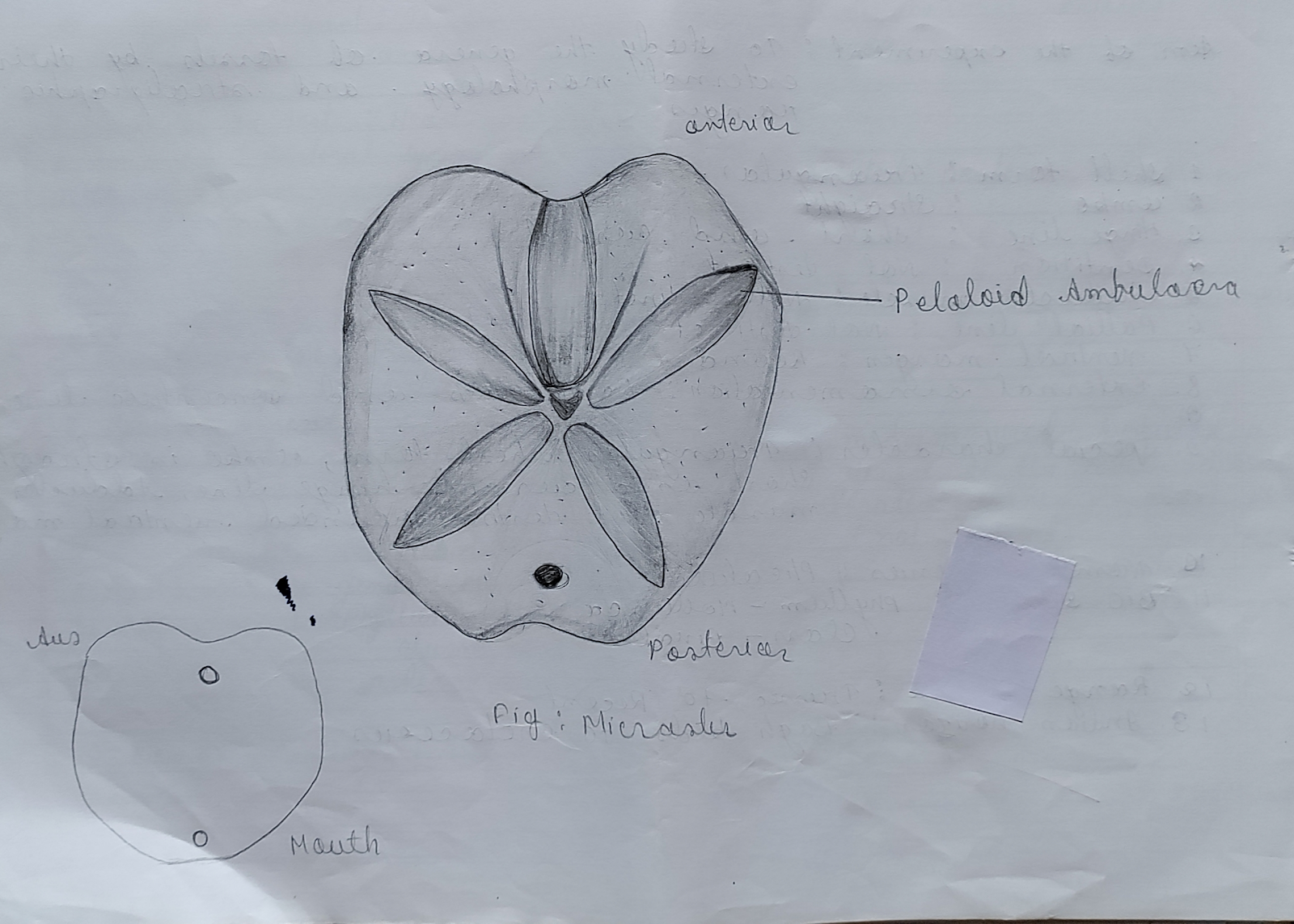CEPHALOPODA
NAUTILUS:
Fig.: Nautilus

- Shell form : Globullar
- Coiling: Planispiral, Involute
- Aperature: Oval
- Siphuncle and septal neck: Siphuncle is central and septal neck is retro-siphonate
- Suture pattern: Nautiloid
- Ornamentation: Shell has smooth growth lines
- Special character: Globular, shell form, oval aperature, coiling is planispiral, involute, siphuncle is central, septal neck is retrosiphonate
- Name of the genus: NAUTILUS
- Bio- status: Phyllum -Mollusca Class -Cephalopoda
- Range in time: Triassic to present
- Indian horizon: Cretaceous to trichinopoly and rannikot
PERISPHINCTES:
 |
| Fig.: Perisphinctes |
- Shell form: Discoidal
- Coiling: Planispiral, evolute
- Aperature :Oval
- Siphuncle and septal neck: Siphuncle is subcentral and septal neck is perisphonate
- Suture pattern: Ammonitic
- Ornamentation: Straight external rib
- Special character: Dicoidal shell form, coiling is planispiral, evolute oval aperature, siphuncle is sub-central and septal neck is prosiphonate
- Name of the genus: PERISPHINCTES
- Bio- status: Phyllum -Mollusca Class -Cephalopoda
- Range in time: Jurrassic
- Indian horizon: Tropiate bed
ORTHOCEROUS:
 |
| Fig.: Orthoceras |
- Shell form: Straight
- Coiling: Conispiral
- Aperature: Sub-rounded
- Siphuncle and septal neck: Siphuncle is sub central and septal neck is retrosiphonate
- Suture pattern: Nautiloid
- Ornamentation: Smooth
- Special character: Straight shell form,coiling is conispiral, sub-rounded aperature, siphuncle is sub-central and septal neck is retrosiphonate
- Name of the genus: ORTHOCEROUS
- Bio- status: Phyllum -Mollusca Class -Cephalopoda
- Range in time: Ordovician to triassic
- Indian horizon: Spiti
TURRITES:
Fig.: Turrites

- Shell form: Turrated
- Coiling: Helicoid
- Aperature: Sub-rounded
- Siphuncle:
- Suture pattern: Ammonitic
- Ornamentation: Tranverse strong rib
- Special character: Turrated shell form, coiling is helicoid, tranverse strong rib, sub-rounded aperature
- Name of the genus: TURRITES
- Bio- status: Phyllum -Mollusca Class -Cephaloada
- Range in time: Creataceous
- Indian horizon: Trichinipoly
TRILOBITA
CALYMERE:
Fig.: Calymere

- Shape and size: Oval
- Cephalon: Triangular, widest part of the body a. Glabella: Bell shaped, tapering upward b. Facial suture and check c. Eyes: Small prominent d. Genal angle: Rounded
- Thorax: 13segments,tapering towards the pygidium, pleural ends are rounded
- Pygidium: Small pygidium,6segments in the axial region which are not distinct in the pleural region
- Specific character: Oval shape, triangular cephalon, globall is bell shaped, small prominent eyes, rounded ginel angle
- Name of the genus: CALYMERE
- Bio-status: Phyllum -Arthopoda Class -Trilobita
Range in time: Silurian to devonian
PHACOPS:
 |
| Fig.: Phacops |
- Shape and size: Ovoid
- Cephalon: Semicircular a. Glabella: b. Facial suture and check: Proparian, small free cheek c. Eyes: Large ,kidney shaped formed of large distinct lenses d. Genal angle: Rounded
- Thorax: 11segment, distinct axial lobe and pleural lob
- Pygidium: Small, semi circular with 9to 11segments
- Specific character: Ovoid shape, semi-circular cephalon, large kidney shaped eyes, rounded ginel angle
- Name of the genus: PHACOPS
- Bio-status: Phyllum -Arthopoda Class -Trilobita
- Range in time: Silurian to devonian
ECHINODERMATA
MICRASTER :
 |
| Fig.: Micraster |
- Shape of the test : Heart shaped , medium in size
- Symmetry : Bilateral symmetry
- Apical system : Periproct ,located at trunckeled posterior margin ,small in size a. Genital plate : 4 In number b. Occular plate : 5 In number , type is insert
- Corona: a. Ambulacra: Ambulacra is in a deep groove locating down to mouth b. Interambulacra : It is broad , perforated
- Peristron : Present (not distinct)
- Spines: Absent
- Special character : Heart shaped test with medium sized, Ambulacra is in a deep groove location down to the mouth , Interambulacra is broard ,perforated spines is absent , peristrone is present (not distinct).
- Name of the genus : MICRASTER
- Bio - status : Phyllum -Echinodermata Class- Echinodea Order- Irregularia
- Range in time : Upper Triassic to recent
CIDARIS:
 |
| Fig.:Cidaris |
- Shape of the test : Hemispherical
- Symmetry : Radial
- Apical system : Periproct is large a. Genital plate : 5 In number,polygonal ,bears genital pores b. Occular plate : Small , triangular ,5 in number
- Corona: a. Ambulacra: Narrow, composed of simple plate b. Interambulacra : Wide, perforate , tubercles present
- Peristron : Small covered with imbricating plates
- Spines: present and long
- Special character : Hemisphrical shape with radial symmetry
- Name of the genus : Cidaris
- Bio - status : Phyllum - Echinodermata Class - Echinodea Order - Irregularia
- Range in time : Upper Jurassic to recent
FORAMINIFERA
NUMMULITES :
Fig.: Nummulites

- Bio- status : Phyllum - Protozoa Class- Sarcodina Order- Foraminera Family – Nummulitidae Genus – Nummilites
- Description : Larger foram , test is vitreous , size range is few mili-meters to 12 centremeter. Consists of four to six whorls .Containing about 15 chambers in the initial whorl and 38-40 chambers in the later whorl. Whorl septa between the chambers are thin oblique and bi- lammellar , lenticular ,discoidal with radiating and concentric ornamentation on the external surface . Internally consisting of a globular proto-culum and numerous planispiral involute coils, Dimorphism in very common.
- Age – Palaeocene to Oligocene
DISCOCYLINA :
 |
| Fig.: Discyclina |
- Bio- status : Phyllum - Protozoa Class- Sarcodina Order- Foraminera Family - Discocyclindae Genus -Discocyclina
- Description : The test is vitreous , typically discoidal , median chambers rectangular , radial septa alternating in position in successive annuli .
- Age – Late cretaceous to late Eocene .
ANTHOZOA
FAVOSITES :
Fig.: Favosites

- Bio- status : Phyllum - Coelenterata Class - Anthozoa Order -Tabulata Family -Favositidae Genus – Favosites
- Description : Favosites are massive , long , branched , polygonal free corallites , numerous tabulae , columella absent.
- Age – Silurian to carboniferous
STYLINA:
 |
| Fig.: Stylina |
- Bio- status : Phyllum - Coelenterata Class - Anthozoa Order -Zoantharia Family -Stylinidae Genus -Stylina
- Description : Massive compound, circular corallites , circular calyx , small styliform columella, corallites united by costae .
- Age – Triassic to eocene

